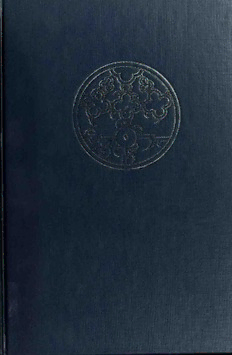
The art of the West in the Middle Ages. Volume 1 : Romanesque art PDF
Preview The art of the West in the Middle Ages. Volume 1 : Romanesque art
M. U. Ar X, Jr 709.02 F68a v.l . ' 1222502 ART AND RECOffDtttGS DEPARTMENT 4 ALLENCOUNTYPUBLICLIBRARY -erp 3 833 00220 2973 1 t I HENRI FOCILLON THE ART OF THE WEST ROMANESQUE ART PHAIDON THE ART OF THE WEST BY HENRI FOCILLON VOLUME ONE ROMANESQUE ART • VOLUME TWO GOTHIC ART • TRANSLATED FROM THE FRENCH BY DONALD KING WITH A GLOSSARY BY P. KIDSON HENRI FOCILLON THE ART THE WEST OF IN THE MIDDLE AGES EDITED AND INTRODUCED BY JEAN BONY VOLUME ONE ROMANESQUE ART • PHAIDON PUBLISHERS INC DISTRIBUTED BY NEW YORK GRAPHIC SOCIETY PUBLISHERS LTD GREENWICH CONN • © 1963 PHAIDON PRESS LTD • LONDON SW7 Original French Text art d'occident, first published by Librairie Armand Colin, Paris PRINTED IN GREAT BRITAIN BY GEO. GIBBONS LTD LEICESTER —— 1222502 CONTENTS EDITOR'S PREFACE PAGE IX • INTRODUCTION PAGE • 3 The Middle Ages, definition of the—West. Architecture and civilisation. Diffusion of styles: one language, the idioms. Medieval life sedentary and local, nomadic and European. Medieval art universal in appeal and encyclopaedic in content. Humanism in medieval art. Periods, techniques and spirituallife. East and West: Romanesque Art CHAPTER THE GREAT EXPERIMENTS: THE ELEVENTH CENTURY I. PAGE 17 I. The Pre-Roman—esque period. The barbarian invasions and the shifting ofvalues. Old settings, new developments TherestorationoftheWesternEmpire. Areturntomonumentalarchitecture. Revivalofthehumanfigureinthedecorativearts.Persistenceofeasternandbarbaricelements.The innovations of the ninth and tenth centuries. II. The great events ofthe eleventh century. The stabilisationofthebarbarians. TherecessionofIslamandtheliberationoftheMediterranean. The adventofstablemonarchies.Therenewa—lofurbanlife.Themenwhogavethecenturyitscharacter. Thehistoricalfunctionofthebuildings Thethreeaspects ofarchitectureintheeleventhcentury. Mediterranean forms: the 'first Romanesque art'; Northern European forms: Ottoman art; Romanesqueforms: thefirst Frenchgroups. III. Theplasticarts. Bronzeandstucco-workin Ger- — many. The revival ofston—ework in the Romanesque areas. Archaic academism: the 'frieze style' and the figures in arcades. The search foramonumental style. Harmony between sculpture and architecture. IV. The vault rib in the eleventh century. The problem ofits origin. The Lombard ribbed vault. The Islamic ribbed vault. The Armenian ribbed vault. The Norman ribbed vault. Bibliography. CHAPTER THE ROMANESQUE CHURCH II. PAGE 62 I. The different periods ofRomanesque architecture and the evolutionofits forms. The transition fromthe eleventh to the twelfth century. The historical factors. Thepartplayedbymonasticism. Cluny. Thegreatpilgrimages andtheirroutes. II. The t—heoryofarchitecture: the basi—c factors. The plan and its—sociological value in Romanesque art. The structure and thevault. The con- ception of mass. The effects: relationships oflight and shade, of solid and void, of plain and decorated surfaces. III. The geography of Romanesque architecture. Some remarks on the term — — 'schools'. T—he principle offiliati—on. Burgundy—: the art ofCluny; the art ofVezelay. Auvergne and Velay. The Rhone valley. Languedoc. Poitou and Saintonge. IV. The Northern zone. CHAPTER (CONTINUED) II Norman art and its expansion. England.—Flanders and neighbouring territories. Imperial art in Germany. The mediterranean zone. Italy. Romanesque art in the crusading territories. Importa- tion. New East-West contacts. Spain. The Holy Land. Bibliography. CHAPTER ROMANESQUE DECORATION III. PAGE 102 I. Theepicsentimentintheiconography. TheApocalypticsource.Visionarytheology.Theancient East. Theophany. The metamorphosis ofman. II. The style.Thearchitectural character ofsculp- ture. The positioning ofRomanesque sculpture. The form determined bythe setting. The capital, the archivolt, the tympanum. The rectangular panel and the principle ofcontacts. Experiments to — achievemovement. Thedecorativecharacterofthesculpture.Romanesquesculptureasadialectic — development. III.Thesources. TheEastChristiancommunities.Syria,Egypt,Transcaucasia,and — — — — Sumerian art. Islam: geometrical forms. Ireland: interlacements. Carolingian art. Local traditions: the Roman art of Gaul. IV. The question of beginnings. The Burgundy-Languedoc — — — problem.TheSpain-Languedocproblem. TheFrenchworkshops. Theperipheralgroups. The evolutionofsculptureinthetwelfthcentury.T—hebaroquephaseofRomanesqueart.V.Romanesque art and colour. The problem ofpolychromy. Relationships ofmetalwork, illumination, and wall- — painting. The architectural rule governing colour. Monumental painting. Technique, groups and workshops. Bibliography. ACKNOWLEDGEMENTS PAGE • 147 ILLUSTRATIONS PAGE • 149 LIST OF ILLUSTRATIONS PAGE • 291 GLOSSARY PAGE • 297 INDEX PAGE • 305 CONTENTS OF VOLUME TWO PAGE • 311
